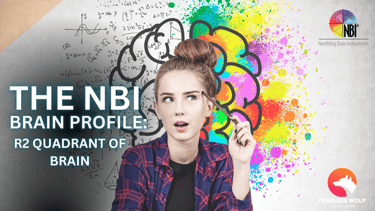Understanding the Relational Thinking Style: Exploring the R2 Quadrant of Kobus Neethling's NBI Brain Profiles
In Kobus Neethling's NBI brain profiling system, the R2 quadrant represents the Relational thinking style. This quadrant provides insights into an individual's preferences when it comes to social, emotional, and interpersonal thinking.
NBI BRAIN PROFILES


Understanding the Relational Thinking Style: Exploring the R2 Quadrant of Kobus Neethling's NBI Brain Profiles
In Kobus Neethling's NBI brain profiling system, the R2 quadrant represents the Relational thinking style. This quadrant provides insights into an individual's preferences when it comes to social, emotional, and interpersonal thinking.
What is the R2 Quadrant?
The R2 quadrant is one of the eight dimensions that measure thinking preferences. It signifies a person's inclination towards relational thinking, which involves considering the impact of emotions, social dynamics, and interpersonal relationships in their thought process.
Characteristics of Relational Thinkers
Individuals who fall into the R2 quadrant typically exhibit certain characteristics that highlight their relational thinking style:
Empathy: Relational thinkers have a natural ability to understand and connect with others on an emotional level. They are sensitive to the needs and feelings of those around them, making them excellent listeners and communicators.
Collaboration: These individuals thrive in team settings and enjoy working with others towards a common goal. They value cooperation, synergy, and the power of collective thinking.
Interpersonal Skills: Relational thinkers excel in building and maintaining relationships. They possess strong interpersonal skills, making them adept at resolving conflicts, mediating discussions, and fostering a positive and harmonious environment.
Intuition: They rely on their intuition and gut feelings when making decisions. Relational thinkers trust their instincts and often consider the emotional implications of their choices.
Emotional Intelligence: Individuals in the R2 quadrant have a high level of emotional intelligence. They are aware of their own emotions and can empathize with the emotions of others, allowing them to navigate social situations with ease.
Applying Relational Thinking
The Relational thinking style has its advantages in various aspects of life:
Leadership: Relational thinkers make effective leaders due to their ability to connect with and inspire their team members. They create a supportive and inclusive work environment that fosters collaboration and encourages the personal and professional growth of their team.
Relationship Building: People with a relational thinking style excel in building and maintaining meaningful relationships. They prioritize open communication, active listening, and empathy, which allows them to establish strong connections with others.
Conflict Resolution: Relational thinkers are skilled at resolving conflicts and finding win-win solutions. They approach conflicts with empathy and strive to understand the underlying emotions and motivations of all parties involved.
Customer Service: In customer-facing roles, relational thinkers shine. Their ability to connect with customers on an emotional level helps them understand their needs and provide personalized and empathetic support.
Embracing Different Thinking Styles
While the Relational thinking style has its strengths, it's important to recognize that different situations require different thinking styles. A well-rounded individual can adapt their thinking preferences based on the context and the needs of the situation.
Understanding the R2 quadrant of Kobus Neethling's NBI brain profiles provides valuable insights into the relational thinking style. By embracing and appreciating different thinking styles, we can foster better communication, collaboration, and understanding in our personal and professional relationships.

